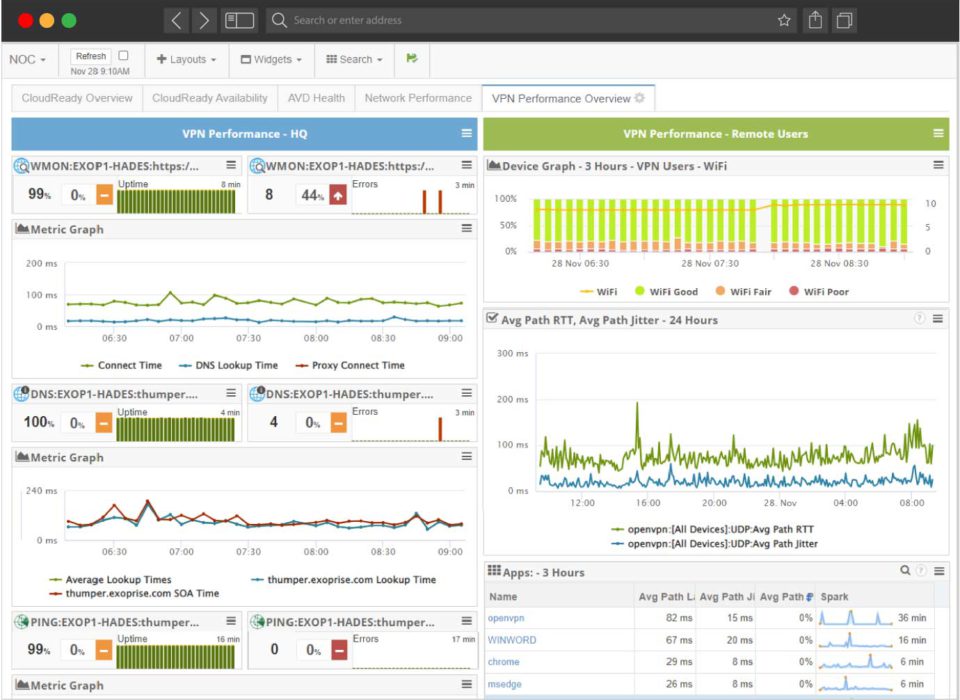VPN Monitoring and Testing
Virtual Private Networks (VPNs) have become a necessity.
Ensure VPN performance and availability with synthetic and real-user monitoring
Virtual Private Networks provide secure and encrypted traffic across the public Internet
VPNs have become a necessity for modern businesses, especially post pandemic with the growth of remote and hybrid work. A Virtual Private Network enables secure and encrypted traffic across public networks and the Internet.
Often, though, corporate VPNs are a source of frustration for employees with poor performance, incorrect configuration, and increased latency or response times.
Primary Use Cases for Business-class Virtual Private Networks
Importance of Monitoring, Testing, and Assessing VPN Connection Performance
Companies require VPNs to safeguard data, facilitate remote access, ensure compliance, and maintain control over network security and internet usage. Private communication channels over VPNs play a critical role in business operations wherever users work.
VPNs also enable Bring Your Own Device (BYOD), promoting secure application access when not using a company sanctioned device. This allows organizations to monitor and enforce secure policies without being intrusive.
While VPNs provide great benefit to security, they add many layers of complexity to network access and are often detrimental to employee digital experience.
Reduced Speed
Internet connection speeds are impacted by VPNs due to servers, encryption, and decryption. VPN bottlenecks vary depending on server load, ISPs, and VPN providers.
VPN Capacity Issues
VPN services, SDWAN, and SASE infrastructures frequently require capacity adjustments to ensure capacity and performance during peak usage.
VPN Compatibility Problems
Applications and services can be incompatible with VPN services and require assessment and testing. Compliance, security, and location dependencies should be evaluated.
Blocked By Websites
Some website services can actively block VPN traffic. When using certain VPNs, users may find themselves not able to access the resource in this case.
Network engineers can continuously test, monitor, and benchmark their business VPN solutions within minutes.
VPN Configuration Complexity Causes VPN Performance Issues
Split tunneling and VPN route manipulation is the source of mistakes, slow performance, and employee frustration. When routing is configured to shape or steer, packets from network sensitive applications like UCaaS can be misdirected through or around the VPN.
Organizations sometimes fail to correctly configure split tunneling and VPN routing. This can lead to poor performance or slow application access. For example, configuring Teams traffic to pass through the VPN instead of routing directly to Microsoft relay servers leads to poor Teams audio, video, or app sharing quality.
Whether an organization uses remote access or site-to-site VPNs, intranet-based or extranet-based VPNs — even personal VPNs — Exoprise proactively tests and monitors the performance and reliability. With the combination of Service Watch RUM and CloudReady synthetics, Exoprise delivers a holistic view of VPNs and routing.

Service Watch — Real-User Monitoring for VPNs
Service Watch Desktop provides detailed telemetry into how applications are accessing the network internally, externally, and across the Internet. It collects metrics critical to diagnosing VPN issues:
Whether employees are working in the office, hybrid, or remote, Service Watch provides detailed diagnostics into the network path performance of VPN clients.

VPN Client Utilization
Capture and continuously record the overhead and resource utilization of VPN clients (CPU, Memory, paging, handles, buffers, etc.)

VPN Latency, packet loss, jitter
Service Watch can monitor VPN latency, jitter, packet loss and hop-by-hop path performance for any protocol and destination servers.
Speed Testing VPNs
Synthetic testing and traffic generation for load-testing or performance monitoring of VPNs is simple with Exoprise CloudReady synthetics. Network tests can be deployed in peer-to-peer, hub and spoke or to any users desktop to provide proactive notifications integrated with any system.
Secure Access Service Edge Monitoring
Secure Access Service Edge (SASE) has become an important initiative for enterprises along with Zero Trust Networks. SASE, Cloud Access Security Brokers (CASB) and cloud proxies combines wide-area networking (WAN) with network security to secure access to corporate and cloud assets.
SASE platforms require testing and impact the employee digital experience. Adding extra network layers, hops, authentication and security inspection will slow access for employees. Exoprise synthetics are designed to be able to proactively test and monitor SaaS applications wherever SASE access is implemented. The network telemetry collected for applications by Service Watch will also reflect the app performance impacts from SASE.
